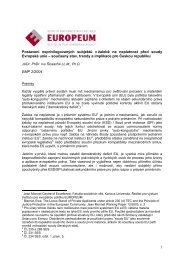eu constitutionalisation - EUROPEUM Institute for European Policy
eu constitutionalisation - EUROPEUM Institute for European Policy
eu constitutionalisation - EUROPEUM Institute for European Policy
You also want an ePaper? Increase the reach of your titles
YUMPU automatically turns print PDFs into web optimized ePapers that Google loves.
Chapter 4: Government Coalitions and Institutional Re<strong>for</strong>m at the IGCtional-behaviour.²⁹ In view of these propositions, I assume that the IGCcontext, as well as the preceding Convention, is conducive to coalitionalbehaviour. The number of members has increased significantly with theenlargement; and in the Convention a host of other actors (national and<strong>European</strong> parliamentarians) were also involved. The situational complexitiesincreased accordingly, and this added to the uncertainties inherent indecisions on institutional provisions. As indicated above, the institutionalprovisions also tend to be highly contested among the member states. Thequestions then poses themselves: what were the key motivations <strong>for</strong> governmentsin choosing to cooperate with other governments in the <strong>for</strong>m ofa coalition? and what types of coalitions occurred as a result?Patterns of coalition-<strong>for</strong>mationInspired by scholars who have studied patterns of coalition-<strong>for</strong>mation withinthe EU legislative processes, I derive hypotheses from the two leading – andoften presented as conflicting – approaches to social explanation: rationalismand constructivism.³⁰ Although a considerable amount of prominentscholarly work on governments’ strategic behaviour in treaty negotiationshas followed the rationalist paradigms, ³¹ there has been a new wave of socialconstructivist oriented works pointing out to the weaknesses in rationalistexplanations and offering alternative views on governments’ motivationsand the role of institutions in treaty re<strong>for</strong>ms.³²According to rationalist scholarship, governments’ behaviour follows thegeneric postulate of rational action: ‘actors are rational insofar as they choosetheir actions from the range of available options that best serve their ends,given their beliefs about available strategy options and their probable consequences’.³³The institutions – rules, norms, procedures and organisationalbodies – constrain the behaviour of governments and provide opportunitystructures.³⁴ They themselves, however, do not have an autonomous impact29) Elgström et al (2001); Midgaard and Underdal (1977).30) Elgström et al (2001); Kaeding and Selck (2005); Mattila (2004).31) Hug and König (2002); König and Brauninger (2004); Magnette and Nicolaidis (2004); Moravcsik andNicolaidis (1999).32) Christiansen (2002); Falkner (2002a); Falkner (2002b).33) Little (1986): 45. Note that ‘beliefs’ are mentioned in rational-choice theories in terms of strategy optionsand strategy preferences. This is different from the usage of word ‘belief’ in constructivist approaches,where it refers to ideological inclinations and values.34) Wallace and Wallace (eds.) (1996): 159.108Chapter 4: Government Coalitions and Institutional Re<strong>for</strong>m at the IGCon negotiation outcomes. The rational-choice explanation of governments’strategic action can then be put into a simple equation: the pre-determinedpreferences and in<strong>for</strong>mation and beliefs about available strategy options ina negotiation situation determine governments’ choices of strategising, andhence also choices of coalitions. These choices follow instrumental motivations,i.e. calculating means and costs to obtain predetermined goals.This article takes into consideration those accounts that suggest that therationalist assumptions of a governments’ capacity to choose between variousalternatives on the basis of clear – exogenously defined – preferences in anin<strong>for</strong>mation-rich environment, may be overstated.³⁵ It is unrealistic to believethat all governments will have fully <strong>for</strong>med preferences when they start thenegotiations, especially when dealing with the complex institutional options. Ifthey do not have fully <strong>for</strong>med preferences which they seek to attain, then theirbehaviour might be driven also by some other motivations, such as learning andgathering in<strong>for</strong>mation in order to <strong>for</strong>mulate preferences or building strategicrelationships. A more complete picture of governments’ behaviour emerges ifwe consider – as maintained by social constructivist scholarship – that governments’behaviour might also reflect socially constructed and widely-recognisedworld views and shared normative notions of ‘appropriateness’ enshrined in theinstitutions and emerging from the interactions within the EU polity.³⁶Social constructivist approaches suggest that all elements of rational-actionmodels – actors, interests and preferences – are ‘socially constructed’; theyemerge from actors’ interaction with institutional structures.³⁷ The EU asa polity consists of a system of principles, rules and procedures that areenshrined in EU institutions and might have socializing effects on governmentsacting in this polity.³⁸ National governments acting on the EU levelsocialise into these shared understandings which consequently influence theiridentities and preferences. Hence, EU institutions determine ‘not only whatactors can do, but influence also their perceptions and preferences – andthus what actors will want to do’.³⁹ Governments’ actions might thus bedriven also by non-instrumental motivations, especially under conditionsof uncertainty and bounded rationality.35) Stubb (2002); Sverdrup (2002).36) Fligstein and Sweet (2002); March and Olsen (1989); Powell and DiMaggio (1991).37) Johnston (2001); March and Olsen (1989); Powell and DiMaggio (1991).38) Risse and Wiener (1999): 776.39) Scharpf (2000): 770.109








